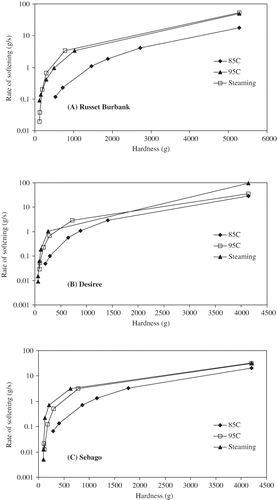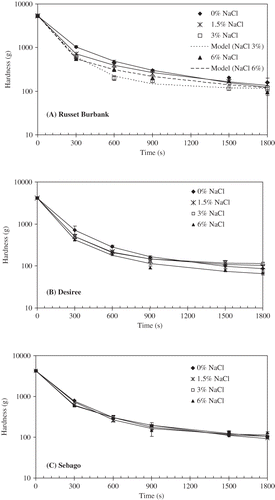Abstract
The change in textural attributes (hardness, chewiness and rate of softening) of three potato cultivars (Russet Burbank, Desiree and Sebago) was investigated. Uniform cylindrical samples (35-mm diameter and 3-mm thick) were prepared and exposed to different thermal processing regimes including; heating at 85°C, 95°C in water and steaming (100.2°C). The effect of salt on these textural attributes was also investigated using different salt concentrations (1.5%, 3% and 6% (w/w) NaCl). After thermal treatments the samples were subjected to texture profile analysis. The instrumental textural attributes were greatly affected by the cultivars and the thermal processing regimes. The change in textural attributes upon steaming was only marginally different compared to that at 95°C in water. Low concentrations of salt (1–3%) were found to accelerate the softening of the texture in these cultivars especially at lower temperatures. The textural attributes were modelled using a two-parameter reaction kinetics model. There was reasonable agreement by the model findings on the textural attributes prepared from all the thermal processing regimes and in presence and absence of (within average absolute error of 1.9–7%). Further, the model indicated that the order of reaction varied from 1.15–2.18 indicating that the changes in textural attributes in these thermal processing regimes followed higher reaction orders.
INTRODUCTION
The textural attributes (hardness, chewiness and rate of softening) of potatoes (Solanum tuberosum L.) are very important quality parameters directly associated with consumer acceptance.[Citation1] The textural characteristics of cooked potato is very important, for example, if the final product is too hard or too soft beyond the consumers preference range, it becomes unappealing to consumers and hence carries greater potential of being rejected.[Citation2] Therefore, it is essential to know the effect of different thermal treatment regimes (temperature and time) such as blanching/heating and steaming on the textural properties of potatoes.[Citation2–5 In addition, understanding of potato texture is important as it is increasingly used as fiber content enhancer in products such as in biscuits. It was found that the use of potato fiber up to 10% delayed the sugar release, increased the crispness and decreased the shrinkage during backing of biscuits, all of which are considered to be desirable properties.[Citation6]
It is believed that the versatility of potatoes is due to different cultivars possessing different textural properties. Some cultivars are preferred over others for some specific products.[Citation7] For example, Russet Burbank is preferred for producing French fries because of its firmer texture, longer dimension, and higher dry matter/starch content.[Citation8,Citation9]. Desiree is long and oval in shape with yellow flesh, contains relatively low starch content and is considered suitable for mashing.[Citation10] Sebago is commonly thick and oval in shape with white flesh, and its starch content falls some where between that of Desiree and Russet Burbank. This cultivar is versatile and is suitable for a number of applications including blanching, steaming, baking and frying.[Citation10] Although these cultivars differ significantly in perceived textural attributes after processing, no comparative studies on the effect of different processing regimes have, so far, been carried out.
During thermal processing, a range of different heating regimes including blanching and steaming can be used. Temperatures between 75–100°C is generally used for blanching or cooking. The choice of the process (blanching/cooking or steaming) determines the temperature-time combination of the process. Apart from the enzyme inactivation (blanching), all the heating methods are directed towards initiating and partially or fully completing gelatinisation.[Citation11] Regarding thermal treatment, blanching is a well studied and is specifically aimed at arresting the enzymatic browning activity.[Citation12] However, when thermal processing is to be carried out in order to precisely control the development of texture (such as hardness, chewiness), much less information is available. Although limited in number albeit detailed studies on the thermal softening of Monalisa cultivar was carried out [Citation5,Citation13] it has not been extended to other cultivars. Other than few limited cultivars, the kinetics of texture development (hardness, chewiness and rate of softening) as a function of different heating regimes is not well understood. What happens to the potato texture when it is steamed has received much less attention despite its importance.[Citation3,Citation4] Therefore, it is necessary that the kinetics of textural changes across different potato cultivars should be thoroughly investigated.
Furthermore, it is a common practice to cook potatoes in common salt solutions in order to impart some desirable flavour, otherwise potatoes cooked in plain water are quite bland. Currently, there is very little information available that elucidates the affect that the presence of salt can have on the textural properties of potatoes. Hence, the aim of this study was to carry out comparative research into the textural kinetics (hardness, chewiness and rate of softening) of Russet Burbank, Desiree and Sebago cultivars at different thermal processing regimes. The heating regimes include two water bath temperatures (85°C, 95°C) and steaming. Furthermore, the effect of salt (NaCl) concentration on the textural kinetics at two processing temperature (85 and 95°C) was also studied.
MATERIALS AND METHODS
Samples and Storage
All potato cultivars (Desiree, Sebago, and Russet Burbank) were collected from the 2008 harvest and purchased from Conapak Produce Company (Ballarat, Victoria, Australia). These varieties were chosen for their significant compositional (total solids and starch contents). The Russet Burbanks are known to have very high dry matter content; and most probably the highest starch content. All potatoes were stored in the dark at an ambient temperature (14–17°C) for the entire duration of testing.
Sample Preparation
Prior to cutting, all tubers were washed and scrubbed (with a non-abrasive cloth) under running water (to remove surface dirt) and rinsed in tap water. The surface water was removed with gentle flow of ambient air. The tubers were sliced at the both ends across the width (with a knife) to produce a flat surface which could be consistently sliced. The tuber was then sliced across the width (3-mm thick) using a handheld Mandolin. The sliced tubers were cut into uniform cylindrical (35 mm in diameter) specimen using a cylindrical food cutter and were extracted from the central portion of the tuber. This procedure minimized large textural variation that could occur between the cortex and the pith tissues of potatoes.
Thermal Processing Regimes
The experiment involved three different thermal processing regimes including blanching/cooking (85 ± 0.5°C and 95 ± 0.5°C) steaming (100.2 ± 0.5°C) and blanching/cooking in salt solutions (85 ± 0.5°C and 95 ± 0.5°C). The entire thermal treatment protocols and texture analyses were performed within an hour to avoid any relaxations in cooked slices over time. Testing was carried out in triplicates.
Blanching/Cooking
Cylindrical tubers were blanched/cooked in a large water bath (15 L, Temperor™, Tecam Company, Australia) which was temperature controlled (ED 190™, Julabo, Germany); within ±0.5°C. In each blanching/cooking run 17 samples were prepared (only 15 were required for texture analyses) to compensate for any damage to the slices during thermal treatment. A plastic mesh basket was used to avoid the slices from colliding with the heating elements and fan blades of the water bath. The water bath was thoroughly cleaned and dried before each sample run. Blanching/cooking was carried out at two temperatures as previously stated. At 85°C, the samples were taken out from the water bath at 5, 10, 15, 40, and 60 min. These slices were immediately cooled by swiftly immersing into cold water. The excess water was removed using dry lint free tissues. At 95°C, slices were taken out from the water bath at 5, 10, 15, 25, and 30 min.
Steaming
The cylindrical slices were steamed in a stove-top steamer and exposed to the same time intervals as samples blanched/cooked at 95°C. The measured temperature during steaming was 100.2°C (±0.5°C). The steamer was thoroughly cleaned and dried between the different steaming runs.
Blanching/Cooking in Salt Solutions
Blanching of slices in different salt solutions followed the same protocol to that of blanching/cooking in water. Three different salt solutions (1.5, 3, and 6% NaCl) were used. The salt solutions were prepared by using the tap water (15 L) with a pre-determined amount of food grade NaCl.
Moisture Content Determination
The moisture content of all samples was determined by drying them in an air oven at 105 ± 5°C for 12 h. Before drying all samples were grated and chopped into a homogeneous paste and weighed out into 2 ± 0.4 g batches and kept on the dryer for 12 h. The dried samples were cooled by storing in a desiccator containing an excess of silica gel beads. Once the samples reached ambient temperature, the final weight was taken. The moisture content was expressed in % (wet basis). The fully dried mass of the sample was taken to be the total solids content. Tests were carried out in triplicates and the values are reported here.
Determination of the Total Starch
The total starch content of the dry samples was determined by rigorously following AOAC Method (996.11). Megazyme Total Starch Kit was used for this purpose. The samples were milled using IKA Grinder A11 (IKA, Australia) to pass 0.5 mm sieve. Circulating water bath with temperature control (ED 190™, Julabo, Germany) to maintain the required temperature. Required centrifugation was carried out at 4000 g (Rotofix 32 A, Hettich, Germany). The calculation procedure was used as suggested as mentioned in the AOAC Method. Tests were carried out in triplicate and the average values are reported here.
Instrumental Texture Analysis
Instrumental textural properties (hardness, chewiness) were determined at room temperature using in built Texture Profile Analysis (TPA) mode using a Texture Analyser (TA.XT Plus™, Stable Microsystems, UK). The texture analyser was calibrated for both probe height (20 mm) and force (2 kg). Cylindrical samples were placed at the platform of the texture analyser and the tests were performed using a stainless steel cylindrical probe (5-mm diameter). The load cell had a maximum capacity of 50 kg. The crosshead speed was 0.50 mm/s, and a relaxation of 5 s was provided between first and second compression (bite) cycles. A deformation strain of 30% of the original length was applied. The textural parameters extracted from each TPA curve include: hardness (peak force during the first compression cycle in grams), cohesiveness (ratio of positive force area during the second compression to that of the first compression), and ‘springiness’ (the height that the food recovers during the time that elapses between the end of the first compression and the start of the second compression, mm). Chewiness is an energy term (g. mm) and was calculated as a product of hardness, cohesiveness and springiness).[Citation14]
MATHEMATICAL MODELING OF TEXTURE KINETICS
A first order reaction engineering model has been used earlier to predict the changes in hardness.[Citation15,Citation16] In addition, two consecutive first order reactions were also used to capture the perceived two mechanisms in thermal softening.[Citation5,Citation13] In both approaches, relative hardness was used by normalizing with initial and infinite hardness values. The temperature dependence of the reaction rate constant is finally calculated using Arrhenius equation. However, the assumption of first order reaction may not be valid because the order of reaction may not necessarily be unity when the potatoes are subjected to different thermal treatment regimes. This is because the driving force that brings changes to the textural attributes might not be the same when the treatment temperature is much higher than the gelatinization temperature or if the media is different (such as during steaming). In this study, the reaction kinetics approach was used allowing the reaction to take ‘nth’ order depending on the nature of the reaction. This approach is commonly used in modeling the change in surface area of catalysts during sintering and densification.[Citation17] The ‘nth’ order reaction for changes in hardness (or any other textural attributes such as chewiness) can take the form of EquationEq. (1):
RESULTS AND DISCUSSIONS
Total Solids and Moisture Content
presents the moisture, total solids and starch contents (% of total solids) of the potatoes tested. This table shows that the Desiree (16.25%) has the lowest, the Russet Burbank (20.82%) the highest total solids content while that of Sebago (20.21%) is very close to that of Russet Burbank. The starch content follows similar trend with Desiree having lowest (51.2%), the Russet Burbank the highest (71.4%) and that of Sebago falling in between (67.7%). The solids and starch contents of Russet Burbank cultivar is similar to those reported earlier.[Citation18]
Table 1 Moisture (%wt), total solids and starch contents of three potato cultivars
Effect of Potato Cultivars on Textural Attribute Kinetics
The effect of potato cultivars on the hardness kinetics at 85°C, 95°C, and steaming are presented in a–c, respectively. These figures show that the Russet Burbank is significantly harder than other two cultivars when blanched/cooked at different temperatures and steamed, and its residual hardness remains well above (less softening) other varieties at any temperature and time. Desiree cultivar appeared to have the softest texture, with Sebago only being slightly firmer than Desiree. These results also indicate that the difference in hardness between these cultivars diminishes as the heating time and temperature increase (more apparent in linear scale). It can also be seen from these figures and that there is a positive correlation between the hardness and starch content of these cultivars, Russet Burbank having the highest (71.4%), the Desiree the lowest (51.2%) and that of Sebago falling in between (67.7%). These results support the previous findings that the textural properties of cooked potatoes depend, to a large extent, on the starch content.[Citation3]
Figure 1 Effect of blanching temperatures and steaming on texture (hardness) of different potato cultivars. (a) 85 ± 0.5°C (b) 9 ± 0.5°C 5°C; and (c) steaming (100.2 ± 0.5°C).
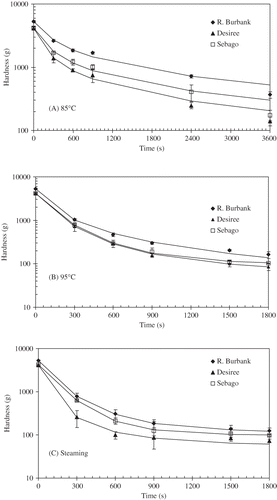
Such a strong positive correlation between hardness kinetics and the starch content especially at 85°C is expected due to the fact that the gelatinisation process is starch content dependent and that it requires finite time for the “moist heat” to induce gelatinisation. For cultivars such as Desiree with low starch content and high moisture the gelatinisation process can proceed reasonably swiftly, while for high solids and high starch potatoes such as Russet Burbank, it requires more time. This finding corroborates with the earlier findings that the different starch levels within potatoes caused a range of variability in texture.[Citation18] Furthermore, potatoes with higher starch levels are expected to have slower heat transfer rate and hence much slower impact on kinetics of texture change.
It has been shown earlier that starch absorbs water during cooking, undergoes some degree of swelling and ultimately gelatinises.[Citation11] The gelatinisation process creates internal pressure, which results into cell separation, reduced cohesiveness and increased softening. Apart from the temperature, these mechanisms require a finite time to complete the process. This explains why the kinetics of hardness (or softening) of Russet Burbank is much slower than especially that of Desiree. Furthermore, not only the total starch content but also the make up of the starch, i.e., the ratio of the amylose and amylopectin polymers may exert stronger effect on the gelatinisation process, which gets reflected into varietal effect on the kinetics of texture changes. It can also be seen in a that at 85°C the difference in hardness between all cultivar decreased over time (more clearly visible on linear scale) indicating that the kinetics of textural attributes depends on the residual texture parameter (such as residual hardness). In this type of processes, the effect of initial texture parameter (hardness or softness) diminishes as time increases.
and c indicates that the difference in the change in hardness over time at 95°C and steaming is not as significant as it is at 85°C. This is probably due to the fact that the potatoes are at a much higher temperature than their respective gelatinisation temperatures. It appears that the driving force of this textural change is the temperature difference between the treatment temperature and the gelatinisation temperature of the potatoes used. Furthermore, the higher this temperature difference, the higher will be rate of heat transfer, which further accelerates the softening process. These findings agree with the earlier arguments that the most rapid change in texture occurred at higher temperatures because of the faster gelatinisation rate.[Citation19] Hence, the much smaller variation between the hardness of different potato cultivars at 95°C and steaming is due to the faster rate of gelatinisation. When the gelatinisation rate is faster, longer treatment times will have much less impact on the textural kinetics. When potato softens faster, it leaves less room for variation in the textural kinetics among different cultivars. It appears that even at these higher temperatures the varietal effect on the kinetics of textural attributes still persists, albeit to a lesser extent. Russet Burbank is slightly harder than Sebago while Desiree is the softest during the entire thermal processing regimes. c further indicates that all the samples after 15 min of steaming appear to be completely softened as indicated by the plateauing of the kinetics plots of these cultivars. When the kinetics curves plateaued, most probably due to completion of the gelatinisation, it appears that all potato cultivars have a comparable hardness.
The Effect of Temperature on Textural Attributes
and present the variation of hardness and chewiness over time when the potatoes were blanched/cooked at 85°C, 95°C, and steamed. It can be seen from these figures that both hardness and chewiness decreased very rapidly as temperature increased. This is due to the fact that the rapid softening and chewiness is driven by greater rate of moist heat penetration and hence the rapid rate of gelatinisation. At higher temperatures much rapid swelling takes place, which creates higher internal pressure, rapid granule separations thereby greatly affecting textural changes.[Citation11] Both gelatinisation and softening are temperature dependent processes. and indicate that the hardness and chewiness are not significantly affected at 85°C compared to at 95°C or when they were steamed. At 85°C, potato samples took relatively longer time to heat up (compared to 95°C and steaming) resulting in slower gelatinisation. Because of this reason, less thermal softening occurs at lower temperatures (85°C) compared to higher temperatures (95°C and steaming).
Figure 2 The effect of blanching and steaming on the hardness of potato cultivars. (a) Russet Burbank; (b) Desiree; and (c) Sebago.
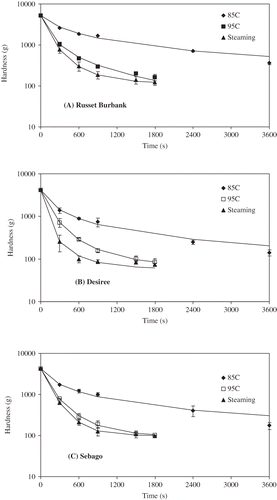
Figure 3 Chewiness of potato cultivar as a function of blanching and steaming. (a): Desiree; and (b): Sebago.

There was less variation in the textural properties among the potato cultivars when they were heated at 95°C or steamed (100.2°C ±0.5°C). This may be due to the very low temperature difference (∼5°C). The extra heat provided through the latent heat of condensation failed to bring about significant change in textural properties Furthermore, and highlight that the decrease in hardness and chewiness occurs rapidly within the first 5 min of treatment irrespective of whether it was heated or steamed. Beyond 5 min, textural degradation was more gradual. Such findings have been reported earlier,[Citation11] and this behaviour is attributed to the greater proportion of crystalline starch granules that gelatinize and swell rapidly at beginning as compared to lesser granules swelling as time progresses. From and , it can be seen further that when these potato varieties were heated at 95°C and steamed, the softening or the decline in hardness and chewiness plateaued very rapidly indicating that there is no need to prolong the thermal treatment even when the maximum softening is required, for example during mashing.
Prediction of the Kinetics and Rate of Change of Kinetics of the Textural Attributes
As can be seen from the solid lines in to that EquationEq. (4) predicts the kinetics of the textural attributes (hardness and chewiness) reasonably well. The average absolute errors in the prediction ranged from 1.9–7%. The final two to three measured data points deviated from the predicted values to a greater extent. Given the data obtained towards the end of the experiments had greater standard deviation in measurements, the slightly higher errors in prediction were expected. presents the extent of variation of K [reaction rate constant (1/s)] and n (reaction order) values when potatoes were subjected to different thermal processing regimes. It can be seen from this figure that the order of reaction (n value) varies between 2.12–2.17 for these varieties at 85°C. The reaction order decreases as the treatment temperature increases and ranges between 1.15–1.30 during steaming. Both K and n values for Desiree variety during steaming are quite different compared to that of the Russet Burbank and the Sebago. This can be attributed to its much lower solids and starch contents (). The n value at 95°C was found to vary between 1.28–1.75. The reaction order of the chewiness was also similar to that of the hardness and in both cases was well above unity. The first order reaction can possibly be assumed in case of steaming, as the n values are not much higher than unity. This indicates that the first order reaction would not be adequate to characterise the kinetics of textural attributes and rate of change of the textural kinetics for these potato varieties within the temperature range covered here except during steaming. From , it can be seen that K value increased as the temperature increased. The ratio Ksteaming/K85C is 3.22, 3.44 and 1.63 for Russet Burbank, Desiree and the Sebago varieties, respectively. This also indicates that the temperature has the greatest effect on the Desiree variety. Similar trend for both the n and K values were found when these varieties were subjected to different salt concentrations which will be discussed in the following section. At this temperature range, different mechanisms for the softening were not visible as reported,[Citation5,Citation13] and hence, two consecutive first order reaction model was not applicable.
Figure 4 The variation of reaction rate (1/s) and the reaction order in predictive equation of hardness of potato cultivars at different thermal treatment regime.
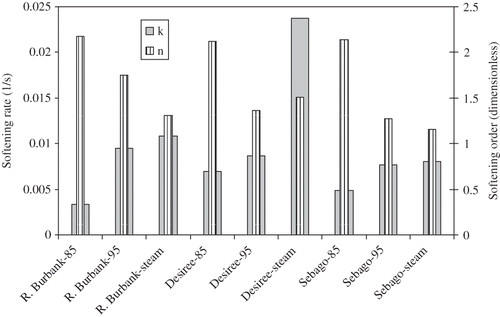
presents the rate of change of hardness (rate of softening) as a function of the residual hardness for these cultivars at all thermal processing regimes. It can be seen from this figure that the rate of softening is the lowest at 85°C for all the varieties and the highest when they are steamed. The softening rate at 95°C is pretty close to each other when they were steamed. One of the interesting features in these figures is that the softening rate is quite high within 15 min of thermal treatment and then falls very rapidly. This effect is very distinct at high temperatures (95 °C and steaming). The rapid fall in the softening rate indicates that the texture has sufficiently softened. The curve at 85°C indicates that the softening process was still progressing towards the end of the tests (1 h).
Effect of Blanching/Cooking in Salt Solutions
and b present the effect of salt solutions on the hardness of Desiree and Sebago varieties at 85°C. These figures indicate that the hardness of potatoes is affected when they are blanched/cooked in salt solutions. Potatoes blanched/cooked in salt solutions have softer texture compared to that of the control (0% salt) at the same temperature. As can be seen from their softening rate curves ( and b) that these potatoes when cooked in salt solutions soften much faster compared to that in pure water. This might be due to increased osmotic pressure of the blanching/cooking medium or possibly be due to the effect of the sodium ion on the starch granules. The higher osmotic pressure and also the sodium ion seemingly have greater rupturing effect that results into accelerated softening of potato texture.
Figure 6 Effect of salt on the hardness of potato cultivars. (a): Desiree; and (b): Sebago at 85 ± 0.5°C.

Figure 7 The effect of salt on the rate of softening of potato cultivars. (a) Desiree; and (b) Sebago at 85 ± 0.5°C.
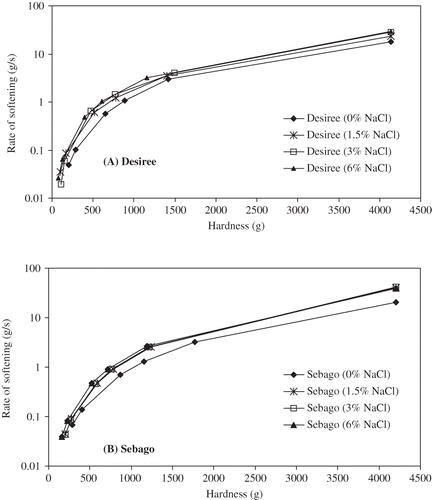
and further indicate that increasing the concentration of salt solution above 1.5% (w/w) only affects the softening rate marginally. The four-fold increase in salt concentration (to 6% w/w) has not brought much greater impact on the softening process compared to that of 1.5%. For both Desiree and Sebago varieties, the softening rate curves almost overlapped indicating that the 1.5% salt solution brings all the possible effect that the addition of salt could bring to the textural attributes. presents the effect of salt solutions on the hardness of all the three potato varieties at 95°C. When this figure is compared with , it can be seen that the effect of salt solution on the softening of potato texture is not as evident as it is at 85°C. This may be due to the fact that the higher rate of heat transfers at high temperatures already softens the potato texture and that there is not much room for the osmotic pressure or the sodium ion to exert their influence. One of the interesting observations that can be made from is that higher than 3% salt concentration do have propensity of slowing down the softening process rather than accelerating it. Hence, it appears that the addition of salt in low concentrations (3% or below) at lower blanching/cooking temperatures (85°C) can accelerate the softening process while this effect is almost negligible at higher temperatures. At higher temperatures, cooking/blanching of potatoes at greater than 3% salt will either have negligible effect on softening or show some propensity of delaying the softening process.
CONCLUSIONS
The Russet Burbank and Sebago cultivars showed higher residual hardness and chewiness over time compared to Desiree due to their higher solids and starch contents. The rate of softening followed a trend based on the starch content with Russet Burbank having the lowest, the Desiree the highest and Sebago falling in between. The effect of cultivar on the kinetics of textural attributes and their rate of change was more evident at 85°C and was relatively weak at higher temperatures (95°C and steaming). Furthermore, the varietal effect on the texture attributes was almost disappeared beyond 15 min of thermal treatment especially at higher temperatures. Addition of small amounts of salt (1.5–3%) accelerated the changes in the textural attributes. The hardness of all the varieties showed more pronounced decline in the presence of salt especially at 85°C, which can be attributed to the increased osmotic pressure and the presence of the sodium ion and their combined effect in swelling and rupture of starch granules. The increase in the salt concentrations beyond 3% was found to have less additional effect. At higher temperatures, the effect of salt on the texture attributes was much less evident. The temperature difference (above the gelatinisation temperature) is apparently the major factor impacting the kinetics of textural attributes. A two parameter reaction kinetics model was found to represent the changes in the textural attribute (hardness and chewiness and rate of softening) reasonably well. The reaction rate constant [K (1/s)] increased with the increase in temperature while the order of reaction showed decreasing trend. The reaction order constants ranged between 2.17 (85°C) and 1.15 (on steaming) indicating that the changes in these textural attributes follow the higher reaction orders.
REFERENCES
- Bu-Contreras , R. and Rao , M.A. 2001 . Influence of heating conditions and starch on the storage modulus of Russet Burbank and Yukon Gold potatoes . Journal of Science Food Agriculture , 81 : 1504 – 1511 .
- Trinette Van Marle , T.J. , Van Der Vuurst De Vries , R. , Wilkinson , C. E. and Yuksel , D. 1997 . Sensory evaluation of the texture of steam-cooked table potatoes . Potato Research , 40 : 79 – 90 .
- Thybo , A.K. , Martens , H.J. and Lyshede , O.B. 1998 . Texture and microstructure of steam cooked, vacuum packed potatoes . Journal of Food Science , 83 ( 4 ) : 692 – 695 .
- Alvarez , M.D. and Canet , W. 1998 . Rheological characterization of fresh and cooked potato tissues (cv. Monalisa) . Lebensm Unters Forsch , 207 : 55 – 65 .
- Zhiqiang , E.L. and Scanlon , M.G. 2007 . Modeling the effect of blanching conditions on the texture of potato strips . Journal of Food Engineering , 81 : 292 – 297 .
- Brennan , C.S. and Samyue , E. 2004 . Evaluation of starch degradation and textural characteristics of dietary fiber enhanced biscuits . International Journal of Food Properties , 7 ( 3 ) : 647 – 657 .
- Singh , N. , Kaur , L. , Ezekiel , R. and Guraya , H.S. 2005 . Microstructural, cooking and textural characteristics of potato (Solarium tuberosum L.) tubers in relation to physicochemical and functional properties of their flours . Journal of the Science of Food and Agriculture , 85 : 1275 – 1284 .
- Blahovec , J. and Esmir , A.A. 2001 . Precise study of cooked potato texture . Journal of Texture Studies , 32 : 165 – 184 .
- Thomas , N.R. 1987 . “ Potato Cultivars ” . In Potato Processing , 4th , Edited by: Talburt , W.F. and Smith , O. New York : Van Nostrand Reinhold Company .
- Wilson , G. 1999 . Potato varieties . Journal of Food Agriculture , 32 : 1 – 4 .
- Nourian , F. and Ramaswamy , H.S. 2003 . Kinetics of Quality Change During Cooking and Frying of Potatoes: Part 1, Texture . Journal of Food Processing Engineering , 26 : 377 – 394 .
- Maté , J.I. , Zwietering , M. and van't Riet , K. 1999 . The effect of blanching on the mechanical and rehydration properties of dried potato slices . European Food Research and Technology , 209 : 343 – 347 .
- Alvarez , M.D. , Canet , W. and Tortosa , M.E. 2001 . Kinetics of thermal softening of potato tissue (cv Monalisa) by water heating . European Food Research and Technology , 212 ( 5 ) : 588 – 596 .
- Bourne , M.C. 1978 . Texture profile analysis . Journal of Food Technology , 78 : 62 – 72 .
- Cunningham , S.E. , Mcminn , W.A.M. , Magee , T.R.A. and Richardson , P.S. 2008 . Effect of processing conditions on the water absorption and texture kinetics of potato . Journal of Food Engineering , 84 ( 2 ) : 214 – 223 .
- Rizvi , A.F. and Tong , C.H. 1997 . A critical review-Fractional conversion for determining texture degradation kinetics of vegetables . Journal of Food Science , 62 ( 1 ) : 1 – 7 .
- Nzihou , A. and Adhikari , B. 2004 . Effect of oxides and nitrates of lead on the sintering and densification of hydroxyapatite adsorbents . Industrial & Engineering Chemistry Research , 43 ( 13 ) : 3325 – 3335 .
- Liu , Q. , Tarn , R. , Lynch , D. and Skjodt , N.M. 2007 . Physicochemical properties of dry matter and starch from potatoes grown in Canada . Food Chemistry , 105 ( 3 ) : 897 – 907 .
- García-Segovia , P. , Andrés-Bello , A. and Martínez-Monzó , J. 2008 . Textural properties of potatoes (Solanum tuberosum L., cv. Monalisa) as affected by different cooking processes . Journal of Food Engineering , 88 : 28 – 35 .
